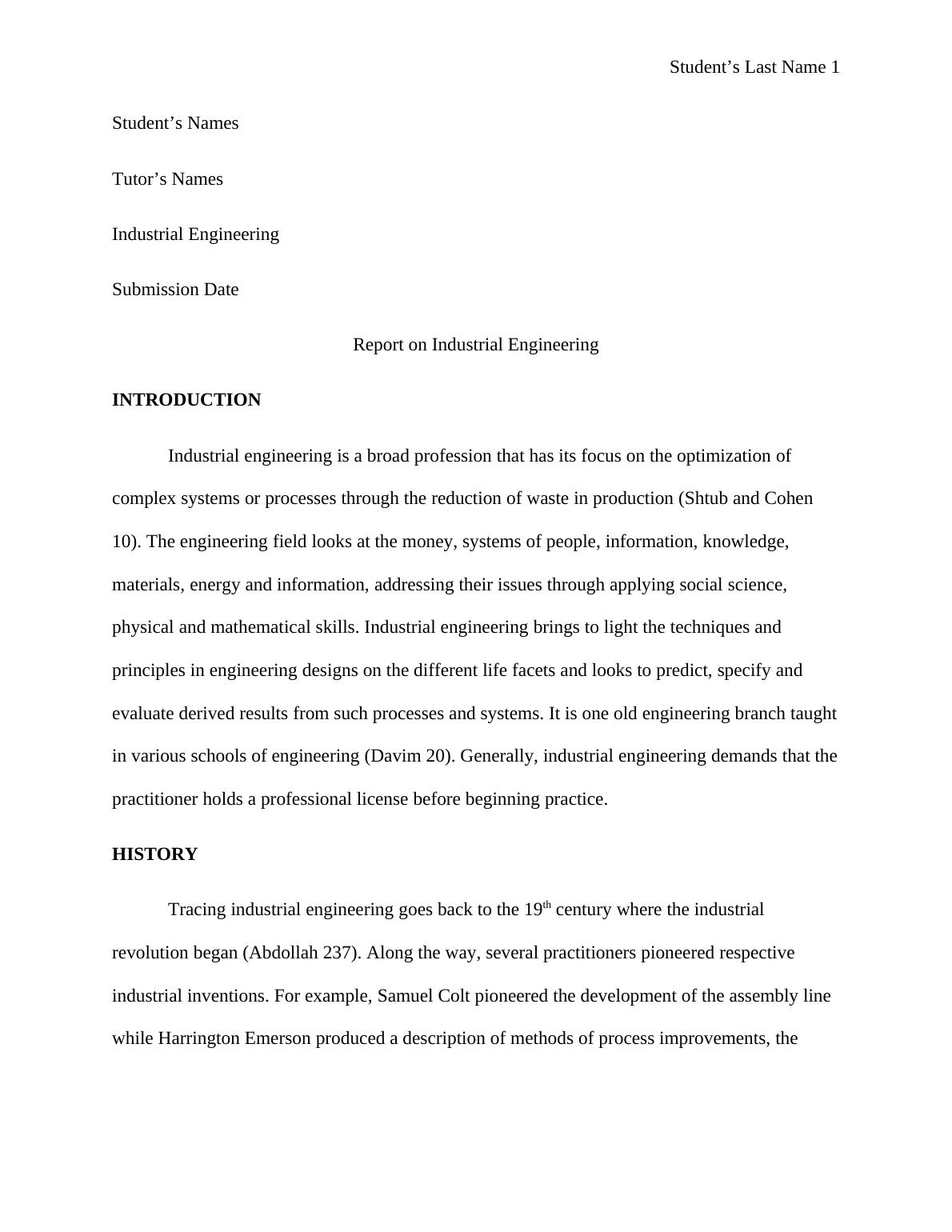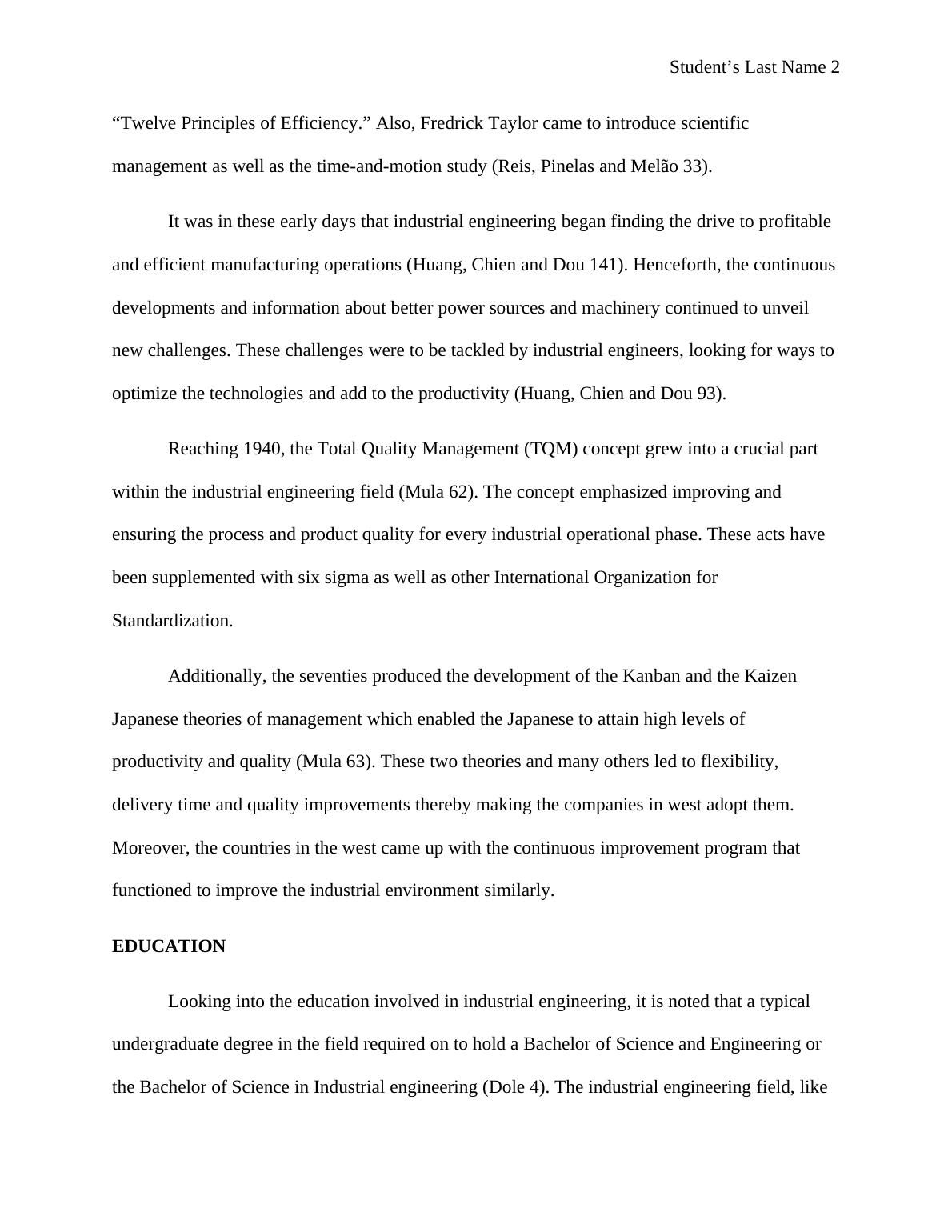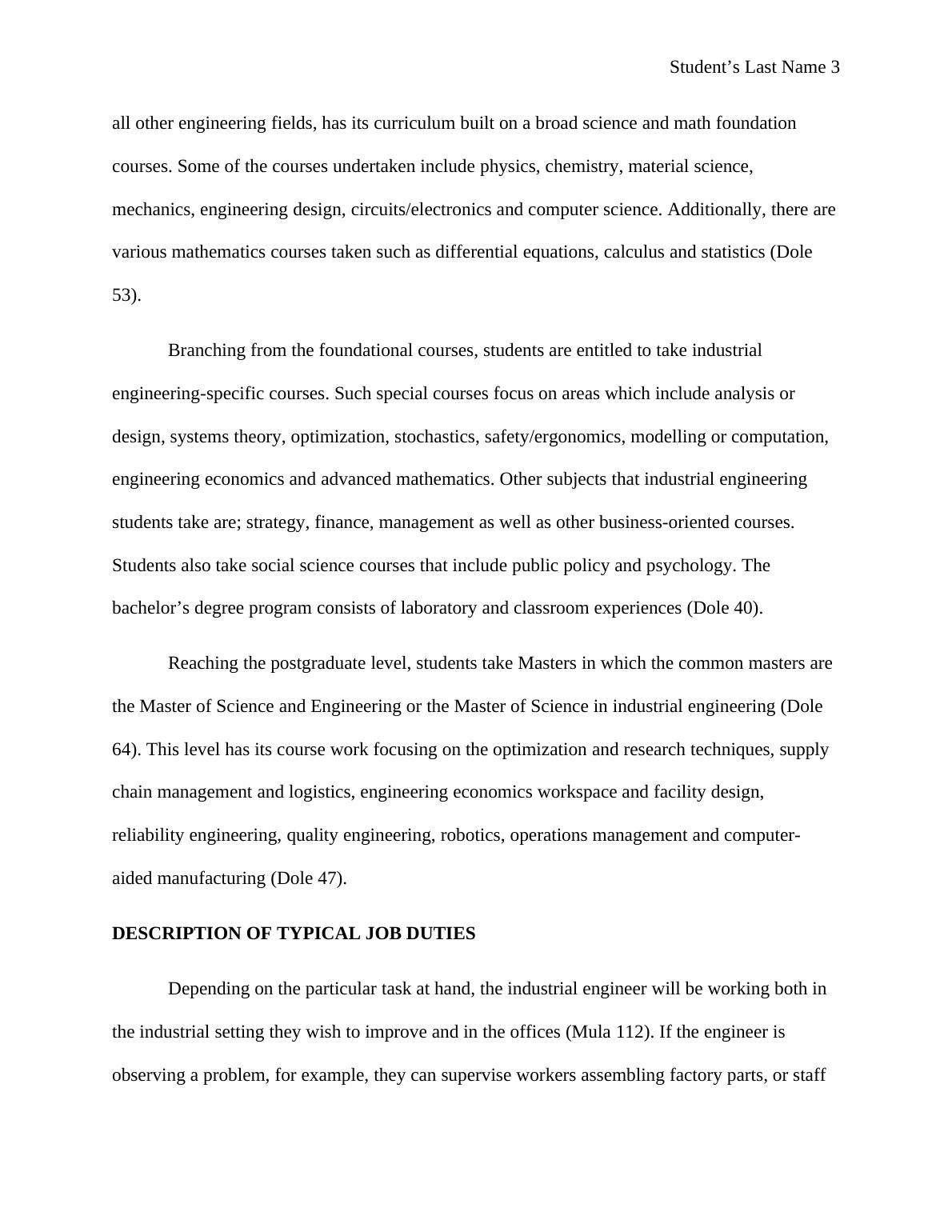Industrial Engineering Submission
8 Pages2017 Words24 Views
Added on 2022-09-09
Industrial Engineering Submission
Added on 2022-09-09
ShareRelated Documents
Student’s Last Name 1
Student’s Names
Tutor’s Names
Industrial Engineering
Submission Date
Report on Industrial Engineering
INTRODUCTION
Industrial engineering is a broad profession that has its focus on the optimization of
complex systems or processes through the reduction of waste in production (Shtub and Cohen
10). The engineering field looks at the money, systems of people, information, knowledge,
materials, energy and information, addressing their issues through applying social science,
physical and mathematical skills. Industrial engineering brings to light the techniques and
principles in engineering designs on the different life facets and looks to predict, specify and
evaluate derived results from such processes and systems. It is one old engineering branch taught
in various schools of engineering (Davim 20). Generally, industrial engineering demands that the
practitioner holds a professional license before beginning practice.
HISTORY
Tracing industrial engineering goes back to the 19th century where the industrial
revolution began (Abdollah 237). Along the way, several practitioners pioneered respective
industrial inventions. For example, Samuel Colt pioneered the development of the assembly line
while Harrington Emerson produced a description of methods of process improvements, the
Student’s Names
Tutor’s Names
Industrial Engineering
Submission Date
Report on Industrial Engineering
INTRODUCTION
Industrial engineering is a broad profession that has its focus on the optimization of
complex systems or processes through the reduction of waste in production (Shtub and Cohen
10). The engineering field looks at the money, systems of people, information, knowledge,
materials, energy and information, addressing their issues through applying social science,
physical and mathematical skills. Industrial engineering brings to light the techniques and
principles in engineering designs on the different life facets and looks to predict, specify and
evaluate derived results from such processes and systems. It is one old engineering branch taught
in various schools of engineering (Davim 20). Generally, industrial engineering demands that the
practitioner holds a professional license before beginning practice.
HISTORY
Tracing industrial engineering goes back to the 19th century where the industrial
revolution began (Abdollah 237). Along the way, several practitioners pioneered respective
industrial inventions. For example, Samuel Colt pioneered the development of the assembly line
while Harrington Emerson produced a description of methods of process improvements, the

Student’s Last Name 2
“Twelve Principles of Efficiency.” Also, Fredrick Taylor came to introduce scientific
management as well as the time-and-motion study (Reis, Pinelas and Melão 33).
It was in these early days that industrial engineering began finding the drive to profitable
and efficient manufacturing operations (Huang, Chien and Dou 141). Henceforth, the continuous
developments and information about better power sources and machinery continued to unveil
new challenges. These challenges were to be tackled by industrial engineers, looking for ways to
optimize the technologies and add to the productivity (Huang, Chien and Dou 93).
Reaching 1940, the Total Quality Management (TQM) concept grew into a crucial part
within the industrial engineering field (Mula 62). The concept emphasized improving and
ensuring the process and product quality for every industrial operational phase. These acts have
been supplemented with six sigma as well as other International Organization for
Standardization.
Additionally, the seventies produced the development of the Kanban and the Kaizen
Japanese theories of management which enabled the Japanese to attain high levels of
productivity and quality (Mula 63). These two theories and many others led to flexibility,
delivery time and quality improvements thereby making the companies in west adopt them.
Moreover, the countries in the west came up with the continuous improvement program that
functioned to improve the industrial environment similarly.
EDUCATION
Looking into the education involved in industrial engineering, it is noted that a typical
undergraduate degree in the field required on to hold a Bachelor of Science and Engineering or
the Bachelor of Science in Industrial engineering (Dole 4). The industrial engineering field, like
“Twelve Principles of Efficiency.” Also, Fredrick Taylor came to introduce scientific
management as well as the time-and-motion study (Reis, Pinelas and Melão 33).
It was in these early days that industrial engineering began finding the drive to profitable
and efficient manufacturing operations (Huang, Chien and Dou 141). Henceforth, the continuous
developments and information about better power sources and machinery continued to unveil
new challenges. These challenges were to be tackled by industrial engineers, looking for ways to
optimize the technologies and add to the productivity (Huang, Chien and Dou 93).
Reaching 1940, the Total Quality Management (TQM) concept grew into a crucial part
within the industrial engineering field (Mula 62). The concept emphasized improving and
ensuring the process and product quality for every industrial operational phase. These acts have
been supplemented with six sigma as well as other International Organization for
Standardization.
Additionally, the seventies produced the development of the Kanban and the Kaizen
Japanese theories of management which enabled the Japanese to attain high levels of
productivity and quality (Mula 63). These two theories and many others led to flexibility,
delivery time and quality improvements thereby making the companies in west adopt them.
Moreover, the countries in the west came up with the continuous improvement program that
functioned to improve the industrial environment similarly.
EDUCATION
Looking into the education involved in industrial engineering, it is noted that a typical
undergraduate degree in the field required on to hold a Bachelor of Science and Engineering or
the Bachelor of Science in Industrial engineering (Dole 4). The industrial engineering field, like

Student’s Last Name 3
all other engineering fields, has its curriculum built on a broad science and math foundation
courses. Some of the courses undertaken include physics, chemistry, material science,
mechanics, engineering design, circuits/electronics and computer science. Additionally, there are
various mathematics courses taken such as differential equations, calculus and statistics (Dole
53).
Branching from the foundational courses, students are entitled to take industrial
engineering-specific courses. Such special courses focus on areas which include analysis or
design, systems theory, optimization, stochastics, safety/ergonomics, modelling or computation,
engineering economics and advanced mathematics. Other subjects that industrial engineering
students take are; strategy, finance, management as well as other business-oriented courses.
Students also take social science courses that include public policy and psychology. The
bachelor’s degree program consists of laboratory and classroom experiences (Dole 40).
Reaching the postgraduate level, students take Masters in which the common masters are
the Master of Science and Engineering or the Master of Science in industrial engineering (Dole
64). This level has its course work focusing on the optimization and research techniques, supply
chain management and logistics, engineering economics workspace and facility design,
reliability engineering, quality engineering, robotics, operations management and computer-
aided manufacturing (Dole 47).
DESCRIPTION OF TYPICAL JOB DUTIES
Depending on the particular task at hand, the industrial engineer will be working both in
the industrial setting they wish to improve and in the offices (Mula 112). If the engineer is
observing a problem, for example, they can supervise workers assembling factory parts, or staff
all other engineering fields, has its curriculum built on a broad science and math foundation
courses. Some of the courses undertaken include physics, chemistry, material science,
mechanics, engineering design, circuits/electronics and computer science. Additionally, there are
various mathematics courses taken such as differential equations, calculus and statistics (Dole
53).
Branching from the foundational courses, students are entitled to take industrial
engineering-specific courses. Such special courses focus on areas which include analysis or
design, systems theory, optimization, stochastics, safety/ergonomics, modelling or computation,
engineering economics and advanced mathematics. Other subjects that industrial engineering
students take are; strategy, finance, management as well as other business-oriented courses.
Students also take social science courses that include public policy and psychology. The
bachelor’s degree program consists of laboratory and classroom experiences (Dole 40).
Reaching the postgraduate level, students take Masters in which the common masters are
the Master of Science and Engineering or the Master of Science in industrial engineering (Dole
64). This level has its course work focusing on the optimization and research techniques, supply
chain management and logistics, engineering economics workspace and facility design,
reliability engineering, quality engineering, robotics, operations management and computer-
aided manufacturing (Dole 47).
DESCRIPTION OF TYPICAL JOB DUTIES
Depending on the particular task at hand, the industrial engineer will be working both in
the industrial setting they wish to improve and in the offices (Mula 112). If the engineer is
observing a problem, for example, they can supervise workers assembling factory parts, or staff

End of preview
Want to access all the pages? Upload your documents or become a member.
